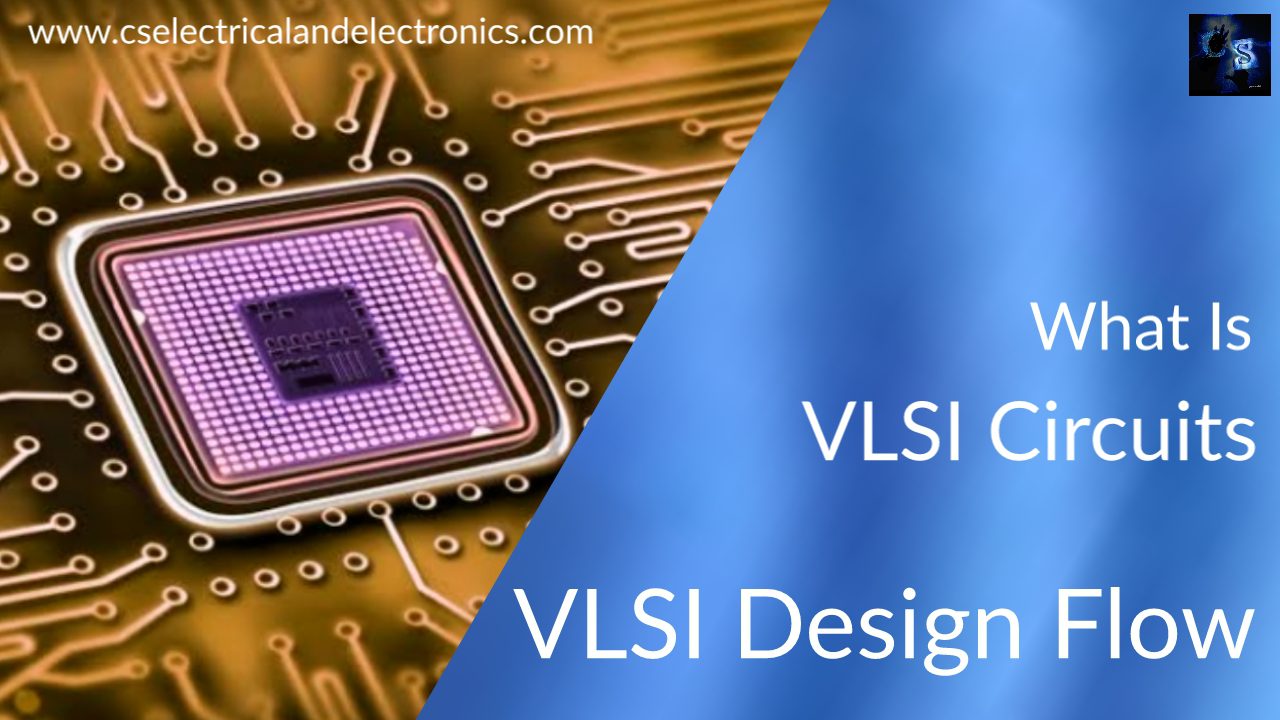What is VLSI, Very Large Scale Integrated Circuit, Design Flow
Hello Guys, welcome back to my blog. In this article, I will discuss what is VLSI or Very Large Scale Integrated Circuit, applications of VLSI, history of VLSI, and the design flow of VLSI. First, I will tell you the full form of VLSI, VLSI stands for a very large-scale integrated circuit.
If you have any doubts related to electrical, electronics, and computer science, then ask questions. You can also catch me on Instagram – CS Electrical & Electronics And Chetan Shidling.
Also, read:
- Differences Between The Clipper Circuit And Clamper Circuit.
- Top 09 EDA Tools For VLSI Chip Design.
- Difference Between LIN, CAN, MOST, FlexRay | Communication Protocols
VLSI Or Very Large Scale Integrated Circuit
What is Integrated Circuit?
The very large-scale integrated circuit is a circuit that contains several transistors fabricated on a single chip.
Let’s discuss classifications of Integrated Circuits, they are classified as;
- Small Scale Integrated Circuit(SSI) – which contains less than 100 transistors. The SSI came in the year 1963.
- Medium Scale Integrated Circuit(MSI) – which contains 100 – 3000 transistors. The MSI came in the year1970.
- Large Scale Integrated Circuit(LSI) – which contains 3000 – 30000 transistors. The LSI came in the year 1975
- Very Large Scale Integrated Circuit(VLSI) – which contains 30000 – 1000000 transistors. The VLSI came into the year 1980.
- Ultra Large Scale Integrated Circuit(ULSI) – which contains more than 1000000 transistors. The ULSI came in the year 1990.
Now I will discuss VLSI and also its objectives.
A very large-scale integrated circuit i.e., VLSI is a process of building a circuit or chip which consists of millions of transistors.
Objectives Of VLSI
- VLSI improves circuit speed.
- It consumes less power.
- VLSI requires less area.
Now I will discuss the VLSI design flow.
01. The idea (need)
02. Specifications
03. Design Architecture
04. RTL Coding
05. RTL Verification
06. Synthesis
07. Foundry
08. IC Chip
These are the steps involved in designing a very large-scale integrated circuit. Let’s discuss it one by one.
01. Idea

The idea may be anything based on the requirement, it may be a microprocessor, micro-controller, memories, and any other requirements. Once the idea is chosen the next step comes specifications.
02. Specifications
This is the crucial step otherwise it will affect the future of the product. Here, vendors may go to get feedback from potential customers on what they are looking for.
- Instruction set.
- Interface (I/O pins).
- Organizations of the system.
- The functionality of each unit in the system, and how to communicate it to other units.
03. Design Architecture
Here the main work starts with the help of the specification sheet the final IC’s architecture is decided and a layout of the circuit is created by engineers using EDA tools.
EDA tools are Xilinx – is design suite, Cadence – Encounter digital IC design, arrived, Synopsys – Astro.

04. RTL – Register Transfer Level
It implies that the VHDL or VERILOG code written based on the architecture describes how data is transformed as it is passed from register to register.
RTL Coding Tools are – Xilinx ISE, Vim, Emacs, ConTEXT, HDL TurboWriter. HDL – HDL means a programming language that can describe the functionality and timing of the hardware.
05. RTL Verification

RTL verification and simulation is one of the important steps. By doing RTL verification we will come to know that the design is logically correct and without having any major timing errors. It is an advantage to perform this step i.e., RTL Verification, especially in the early stages of the design.
RTL Verification tools – Modelsim, Xilinx ISE, Verilog -XL, Finsim, TestBuilder, etc.
06. Synthesis
Synthesis is where the design now starts to get physical. Logic synthesis is a process by which the desired behavior of the circuit i.e., Register Transistor Level is turned into a design in terms of logic gates that drives the circuit or architecture.
Synthesis Tools or Kit – FPGA (Altera, digiland, Xilinx) and CPLD (Altera, digiland).
FPGA kit – FPGA kit is an IC that can be programmable by the user to capture the logic. The kit is capable of capturing 100,000 designed gates.

07. Foundry

The design is now ready for fabrication for mass production to the foundry.
08. IC Chip

In the end, IC chips are ready.
Applications Of VLSI

- Consumer Electronics
- Wireless & Wireline
- Electronic Design Automation
- Medical Electronics
- Automotive Electronics
- Aerospace
- Defense
- MEMS & Bio-Electronics
These are the applications of VLSI Or Very Large Scale Integrated Circuit.
I hope this article may help you all a lot. Thank you for reading. If you have any doubts related to this article “What is VLSI, Very Large Scale Integrated Circuit”, then comment below in the comment box.
Also, read:
- 100 + Electrical Engineering Projects For Students, Engineers
- 1000+ Automotive Interview Questions With Answers
- 1000+ Electronics Projects For Engineers, Diploma, MTech Students
- 1000+ MATLAB Simulink Projects For MTech, Engineering Students
- 50 Advanced Level Interview Questions On CAPL Scripting
- 500+ Embedded System Projects For Engineer, Diploma, MTech, PhD
- 500+ Projects For Diploma Electrical, Electronics Student, Diploma Project
- 8051 Microcontroller Timers, TCON Register, TMOD Register
- A Complete Guide To FlexRay Automotive Protocol
- Adaptive AUTOSAR Vs Classic AUTOSAR: Which One For Future Vehicles?

